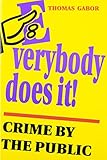Everybody Does It! : Crime by the Public / Thomas Gabor.
Material type: TextPublisher: Toronto : University of Toronto Press, [2001]Copyright date: ©1994Description: 1 online resource (378 p.)Content type:
TextPublisher: Toronto : University of Toronto Press, [2001]Copyright date: ©1994Description: 1 online resource (378 p.)Content type: - 9780802068286
- 9781442674691
- 364.3
- HV6080
- online - DeGruyter
| Item type | Current library | Call number | URL | Status | Notes | Barcode | |
|---|---|---|---|---|---|---|---|
 eBook
eBook
|
Biblioteca "Angelicum" Pont. Univ. S.Tommaso d'Aquino Nuvola online | online - DeGruyter (Browse shelf(Opens below)) | Online access | Not for loan (Accesso limitato) | Accesso per gli utenti autorizzati / Access for authorized users | (dgr)9781442674691 |
Browsing Biblioteca "Angelicum" Pont. Univ. S.Tommaso d'Aquino shelves, Shelving location: Nuvola online Close shelf browser (Hides shelf browser)

|

|

|

|

|

|

|
||
| online - DeGruyter Ethics and Capitalism / | online - DeGruyter Ethnicity, Politics, and Public Policy : Case Studies in Canadian Diversity / | online - DeGruyter European Literary Careers : The Author from Antiquity to the Renaissance / | online - DeGruyter Everybody Does It! : Crime by the Public / | online - DeGruyter Executive Styles in Canada : Cabinet Structures and Leadership Practices in Canadian Government / | online - DeGruyter Exiled From Light : Divine Law, Morality, and Violence in Milton's Samson Agonistes / | online - DeGruyter Exorcism and Its Texts : Subjectivity in Early Modern Literature of England and Spain / |
restricted access online access with authorization star
http://purl.org/coar/access_right/c_16ec
This is the first book to explore in detail crime committed by the general public. Thomas Gabor challenges the prevailing stereotype of the criminal by documenting the extent to which ordinary citizens (those who are not habitually in conflict with the law) violate the law, exhibit dishonesty, or engage in actions harmful to their fellow citizens. He shows that so-called respectable citizens account for a large proportion of many kinds of crime: theft, fraud, tax evasion, assault, sex offences, business scams, political and corporate crime, environmental crime, technological crime, and mass lawlessness such as looting and vigilantism. He also discusses crime by police and other authorities in the justice system. Case studies provide concrete examples and raise crucial questions about law enforcement.By discussing the justifications and excuses ordinary people provide for their transgressions, Gabor draws a parallel between those justifications and the ones provided by chronic or hard-core criminals. He shows, through experimental and other evidence, that members of the public are often not firmly committed to society's laws or the legal system. Using existing theories in conjunction with an original, interdisciplinary theoretical model, he shows why criminality is so widespread, and why it varies from person to person, and from one milieu to another. He shows why some crimes are more prevalent than others, and why some people are more immune to being labelled and processed as criminals within the criminal justice system. He concludes with a discussion of approaches for dealing with widespread criminality.
Mode of access: Internet via World Wide Web.
In English.
Description based on online resource; title from PDF title page (publisher's Web site, viewed 01. Nov 2023)


